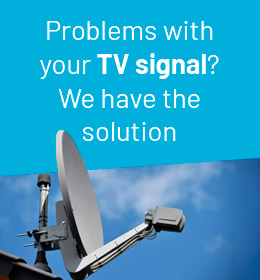In this day and age, television has become an integral part of our daily lives. It serves as a source of entertainment and information, and it is hard to imagine existence without it. However, sometimes we have problems with the television signal.
 Whether it’s pixelated images, poor sound quality or total signal loss, it can be frustrating and annoying. Fortunately, there are several steps you can take to troubleshoot your TV signal and restore a clear viewing experience.
Whether it’s pixelated images, poor sound quality or total signal loss, it can be frustrating and annoying. Fortunately, there are several steps you can take to troubleshoot your TV signal and restore a clear viewing experience.
In this article, we’ll walk you through each step in detail, outlining the most common causes of signal problems and providing practical solutions to help you troubleshoot them. So sit back, relax and dive into the world of TV signal troubleshooting.
Contents
Causes of Signal Interruptions
One of the most common causes of signal interruptions when watching TV is interference from other electronic devices, such as microwaves, cordless phones and wireless routers. These devices emit electromagnetic waves that can interfere with the television signal, causing a loss of clarity or even total loss of signal.
To avoid signal interference, it is recommended to keep these devices away from the TV set and reduce their use while watching TV. In addition, it is important to check the cables and connectors between the TV and the cable or satellite box and make sure they are properly connected. If signal loss persists, it may be necessary to call a professional technician to diagnose and resolve the problem.
By taking these precautions and seeking outside help when necessary, viewers can enjoy an uninterrupted, high-quality television experience.
Signal interruptions can be frustrating for anyone who relies on their television for entertainment or information. One possible cause of this problem is external factors such as extreme weather conditions, which can affect signal transmission.
Troubleshooting your TV signal problems
In addition, physical obstacles such as walls, trees and hills may prevent the signal from reaching the TV. In these cases, it may be necessary to seek the advice of an antenna specialist who can guide you in finding the best location for your antenna.
The specialist may suggest that you move the antenna to a location that is not obstructed by any of these elements, or recommend a more powerful antenna that can pick up signals over a greater distance. Whatever the case, it is important to resolve signal interruptions promptly to avoid further inconvenience.
Ultimately, there can be several reasons why a TV displays the “no signal” message. We have outlined some of the most common reasons and solutions to fix the problem. If the problem persists, it may be worth consulting an antenna specialist to determine if the antenna or cable connection is faulty or improperly installed.
A specialist can help identify and diagnose the problem, and offer a solution to ensure that your TV receives uninterrupted signals. To avoid further interruptions, it is necessary to invest in high-quality cables and properly install the cable routing, antenna and amplifiers.
In addition, regular maintenance and upgrading of TV equipment is also necessary to ensure a trouble-free viewing experience.
Situation Analysis: Troubleshooting Tips
When a TV indicates that it has no signal, there may be several causes. One way to troubleshoot the problem is to start by checking the cables connected to the TV. It is important to make sure that all cables are securely attached and working properly. A loose or broken cable could be preventing signal reception, resulting in a no signal message.
Therefore, it is essential to carefully examine each cable connection and check for any defects or wear. This step should be taken before moving on to other possible causes of the problem. By regularly inspecting and maintaining cable connections, potential connectivity problems that could affect the viewing experience can be avoided. Investing time and effort in making sure all cables are in good condition will end up saving you time, money and frustration in the long run.
Solutions for loss of signal on your TV set
When your TV indicates that it has no signal, there may be several reasons for this to occur. Checking the antenna, cables and connections is the first step in identifying and resolving the problem. If the problem persists, it may be time to contact an antenna specialist to assess the situation. In addition, it is important to note any recent changes in your home that may be blocking the signal, such as moving furniture or installing a new router.
Adjusting the location of items that may be interfering with the signal or resetting the router settings may be enough to resolve the problem. By following these steps, you will be able to enjoy your TV programming without interruptions
Get back to enjoying your programming!
Basic Steps to Troubleshoot TV Signal Problems
A common problem faced by many TV owners is a lack of signal. This can be particularly frustrating when trying to catch up on the latest news or watch a favorite show.
One of the most common reasons for the lack of signal is a faulty or loose antenna cable. To fix this problem, it is important to check that the antenna cable is securely connected to the TV and power outlet. If this does not solve the problem, it may be necessary to consult an antenna specialist. This professional can help identify any structural or environmental factors that may be affecting signal transmission, such as obstructions or distance from the transmitter.
Optimizing your TV signal
He can recommend and install higher quality equipment that can improve signal strength and quality. Working with an antenna specialist will ensure that your TV always gives you a clear and uninterrupted viewing experience.
So, one of the possible causes of a TV not having a signal could be a problematic antenna cable. To determine if this is the case, it is recommended to check if the antenna cable is properly connected. If it is not, you should reconnect it properly.
However, if the problem persists, it is advisable to try another device or component with the same antenna cable to evaluate if it is providing a good signal. If it is not, it could mean that the Boundary Wire itself is defective and should be replaced. In such cases, it is highly recommended to seek the help of a professional technician to ensure that the problem is resolved as effectively as possible.
When is it time to contact a professional?
When the TV indicates that it has no signal, it means that it is unable to receive any programming from its source. This can be due to several reasons, such as a faulty cable connection, cable receiver or TV antenna. To troubleshoot the problem, it is important to first check all cable connections and make sure they are properly plugged in. If the problem persists, it may be necessary to replace the cables.
Another possible cause of the problem could be a malfunction of the cable receiver, which can be resolved by restarting it or contacting the service provider for assistance. In some cases, the TV antenna may also be the cause of the problem and may need to be repositioned or replaced. In addition, checking and replacing the batteries in the remote control may also help solve the problem.
Consultation with an antenna specialist
It is important to follow these steps one by one until the problem is resolved. This way, you can ensure that your TV is working properly and enjoy your favorite programs without interruption.
Also, if you have tried all of the troubleshooting steps and your TV still shows no signal, it is best to consult an antenna specialist. A professional technician has the experience and tools to identify the cause of your TV’s lack of signal and provide you with a customized solution.
In addition, they can also check the condition of the antenna and make any necessary adjustments or repairs. Investing in an antenna specialist can save you time and money in the long run by ensuring the optimal performance of your TV. Remember that taking proactive steps to maintain your TV’s performance can extend its life and improve your overall viewing experience.
Common Solutions to TV Signal Problems
When your TV indicates that it has no signal, it can be frustrating for viewers who depend on it for entertainment or information. Fortunately, there are several common solutions to TV signal problems that can be tried before resorting to more complex repairs or replacements. One possible cause of a signal problem may be faulty cables or connections.
Checking Cables and Settings: Solutions for Resetting the TV Signal
If this is the case, checking that all cables are properly connected to the TV and any external devices, such as a cable box or DVD player, may help to restore the signal. Another possible solution is to make sure the TV is set to the correct input. This may require using the remote control to select the desired input, such as HDMI or AV.
Finally, adjusting the antenna or dish can also help improve signal quality. This may involve changing the position of the set or making small adjustments to its orientation. In general, if the TV is not giving a signal, these strategies can be effective in resolving the problem and restoring access to a quality broadcast.
Optimizing the Connection: Key Steps to Solving Loose Cable Problems
When a TV indicates that it has no signal, it can be frustrating for the user. One of the possible causes of this problem can be loose cables or incorrect connections. To fix this problem, it is necessary to carefully check all cables and connections. This involves inspecting each one for any signs of looseness or disconnection and troubleshooting any problems that may be found.
To ensure that the connections are secure, tighten the connectors if necessary. In addition, it is essential to make sure that all cables are properly connected to the appropriate ports on the TV and any other devices involved in the installation. In general, paying close attention to the cables and connections is crucial when dealing with a lack of signal problem, and taking the time to examine them can help to effectively resolve the problem.
Understanding the problem: Causes and solutions when the TV does not give a signal
In addition, it is crucial to understand what it means when the TV does not give a signal at all. One possible cause may be due to a problem with the TV’s tuner or built-in receiver. In such cases, it may require the assistance of a professional technician to diagnose and repair the problem. Other reasons could be related to problems with the signal source itself, such as problems with cable or satellite service or poor weather conditions.
However, following the above steps of checking connections, adjusting antennas or dishes, and selecting the correct input or channel can help solve the problem in most cases. By following these tips, viewers can ensure optimal operation of their TV sets and enjoy uninterrupted entertainment.
Maximize your viewing experience
When your TV indicates that it has no signal, it can be frustrating and negatively affect your viewing experience. This problem can have a number of causes, such as a poor antenna or cable connection, signal interference or outdated equipment.
To remedy this situation, one of the simplest solutions is to ensure that the TV is receiving a strong signal. To do this, check the power outlet connections and make sure they are secure. Often, loose or faulty connections can cause a weak or non-existent signal. By making sure all connections are secure, you can increase signal strength and put an end to the problem of signal loss.
In short, having no signal is frustrating for viewers, but checking and tightening all connections is an easy fix to help ensure the ultimate viewing experience. When you’re experiencing signal loss, it’s important to consider all possible causes and solutions before giving up on the viewing experience altogether.
Also, when your TV is not giving a signal, investing in an antenna or digital converter box can be a cost-effective solution. These devices can help you receive a better signal and access channels and programming smoothly.
It is essential to keep in mind that choosing the right antenna is crucial to getting the best results. Be sure to evaluate your location and signal strength before making any purchases. Also, if you are using an older TV, upgrading to a newer model can also help improve signal reception.
With all of these possible causes and solutions, you can enjoy an uninterrupted viewing experience and quality programming with ease.
In conclusion, TV signal problems are a common frustration for viewers. However, if you have the knowledge described in this step-by-step guide, you can easily solve most signal problems.
By following the practical solutions provided here, you can enjoy a crystal clear viewing experience and never miss a moment of your favorite programs again. Remember that a little patience and perseverance can go a long way in solving TV signal problems, so don’t give up until you’ve tried everything.
We hope you found this article helpful and wish you the best in your troubleshooting journey.







